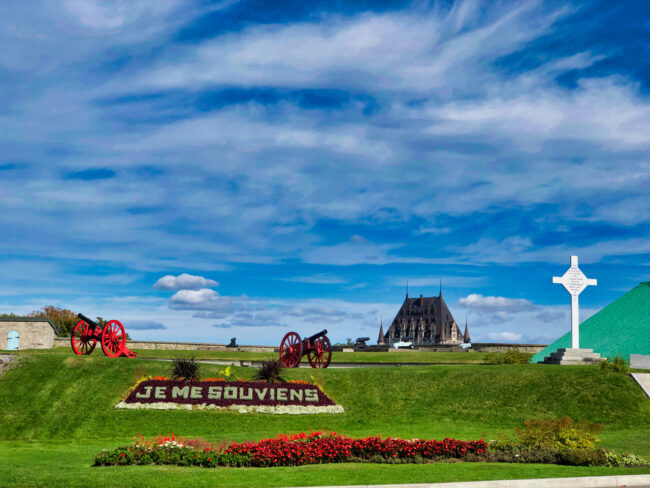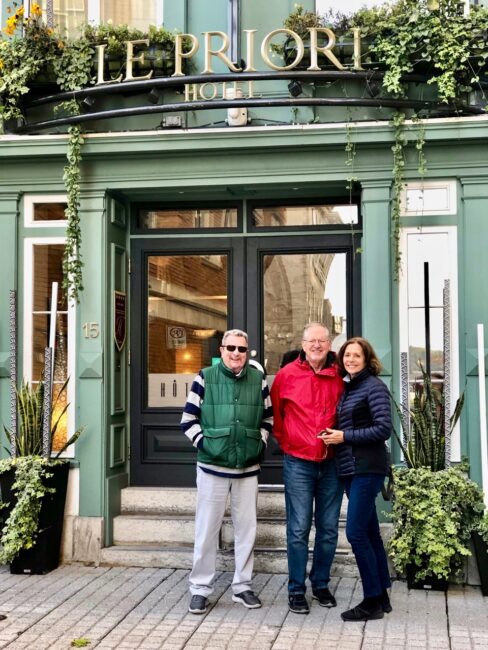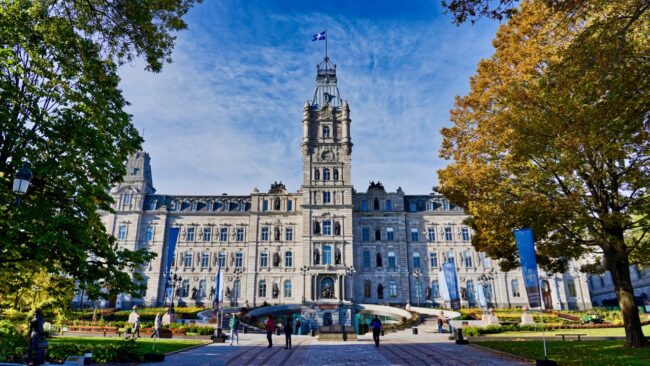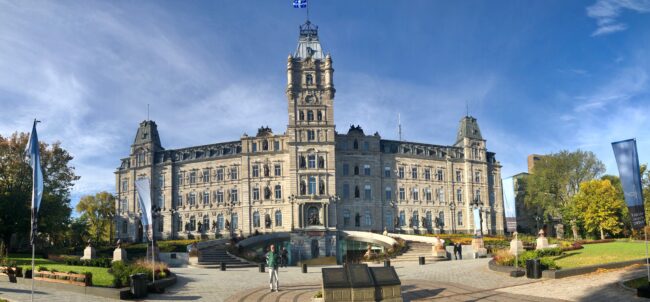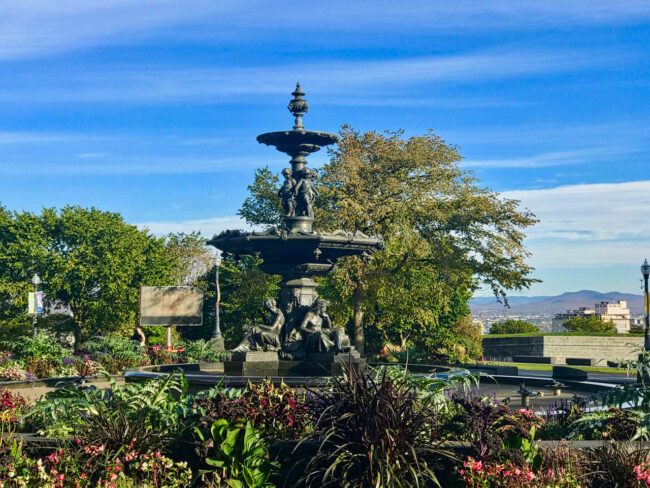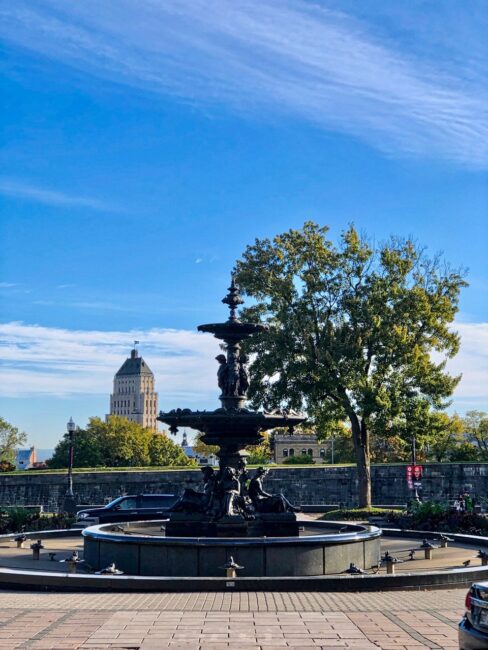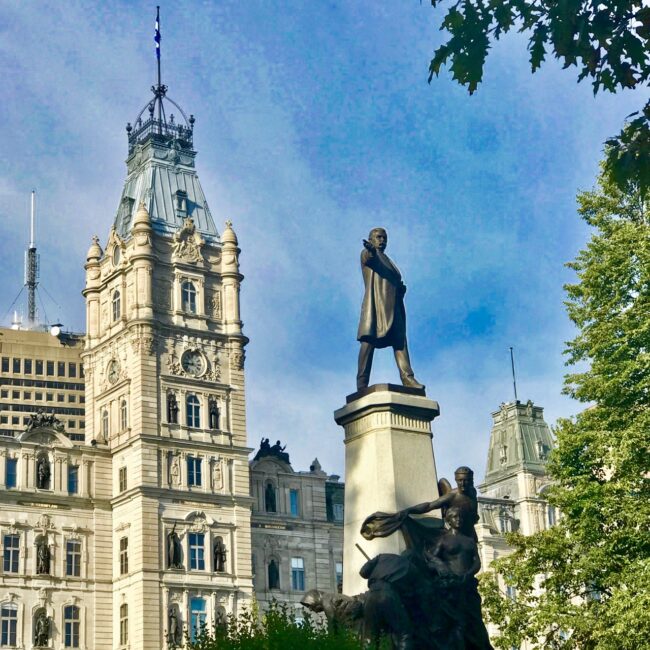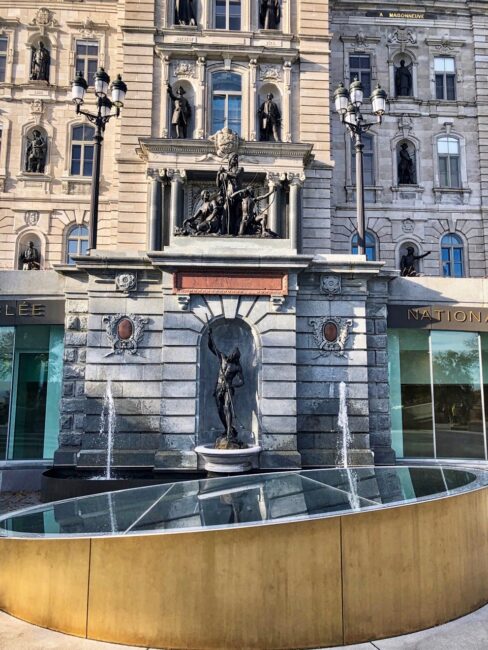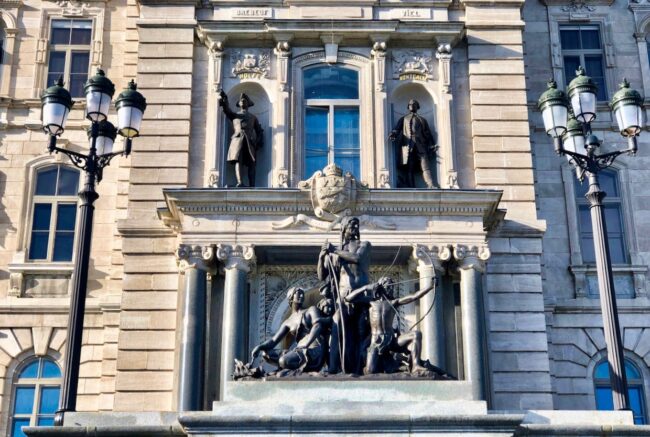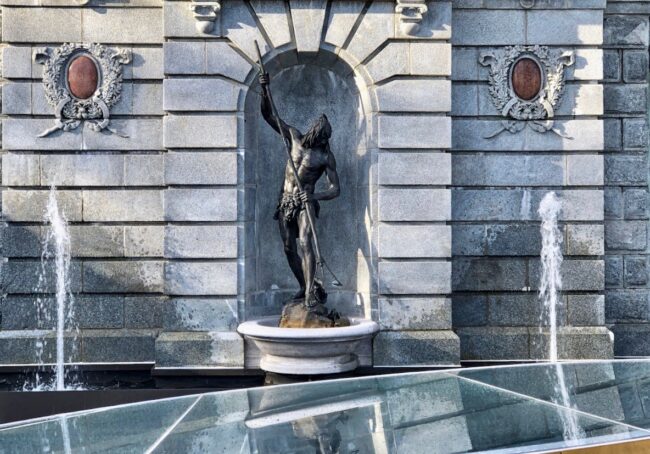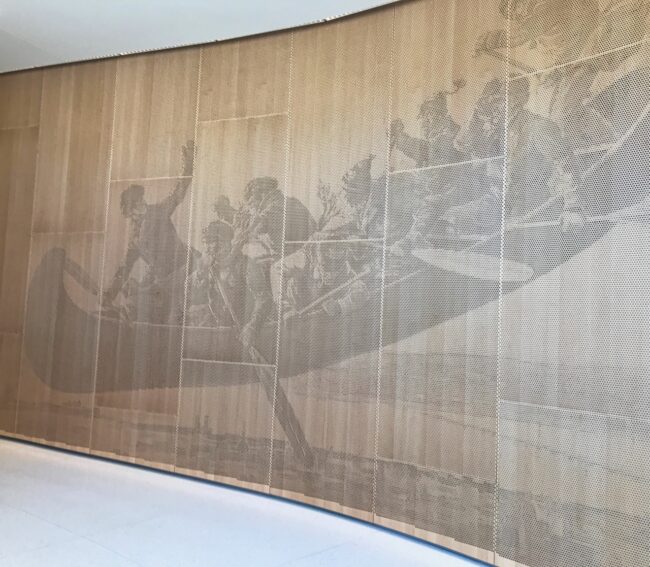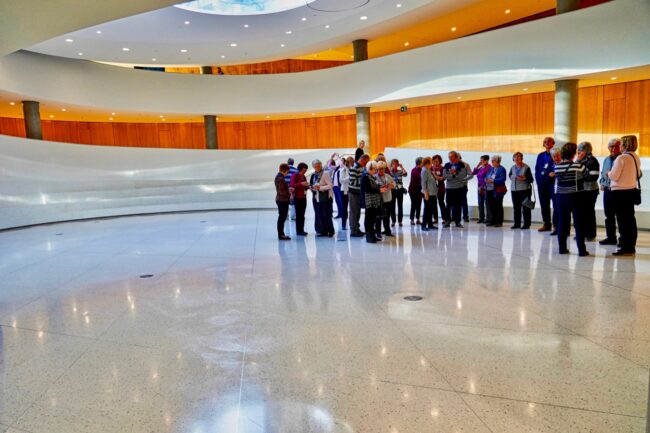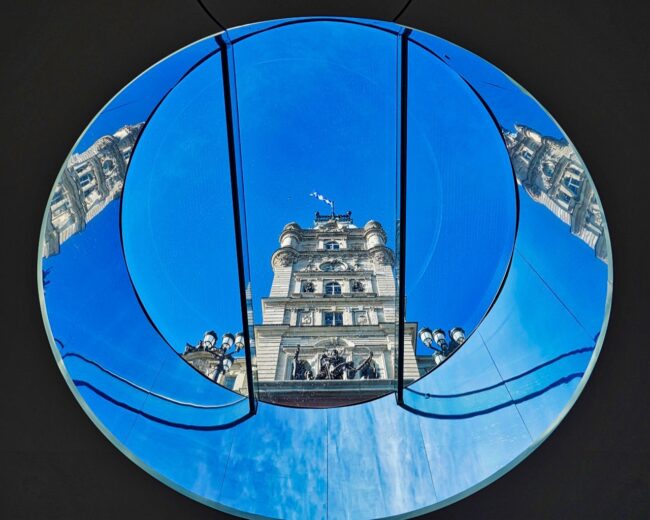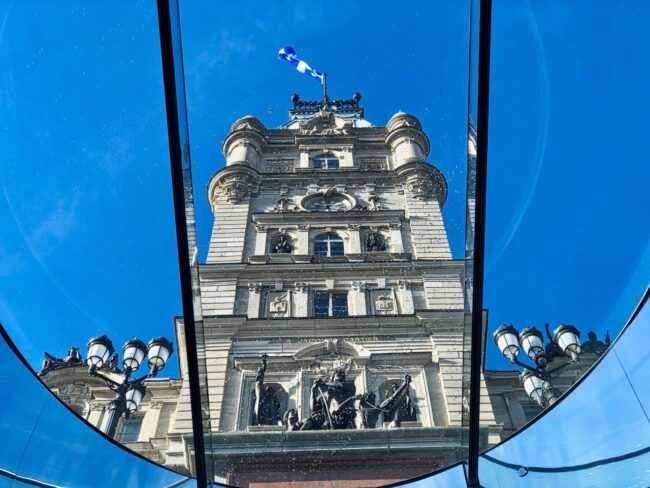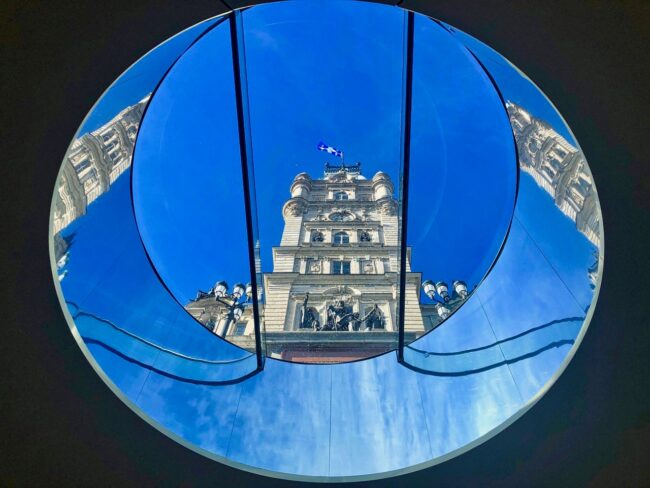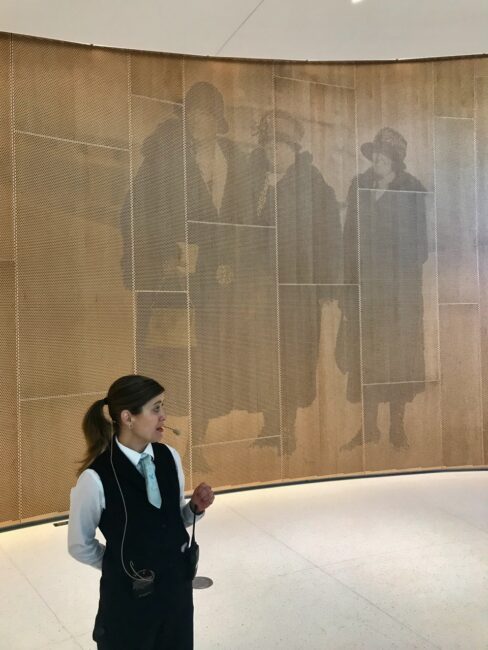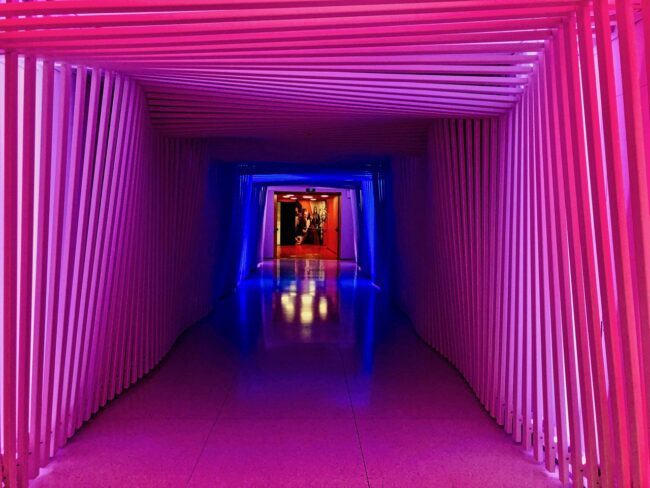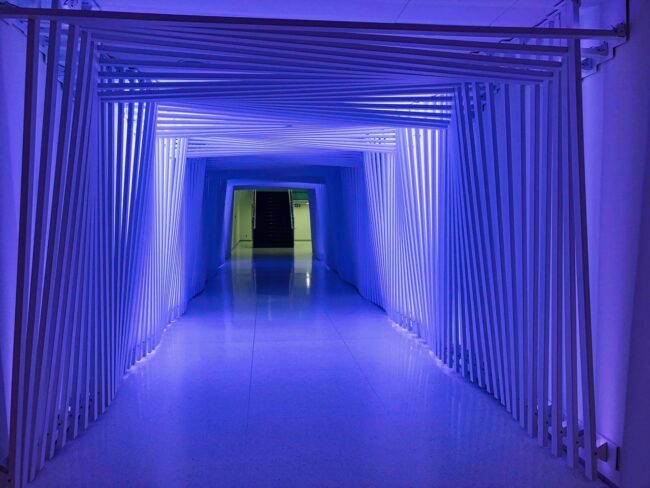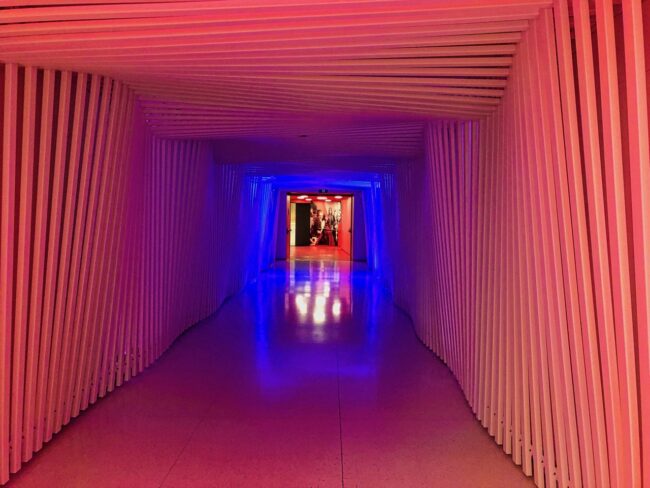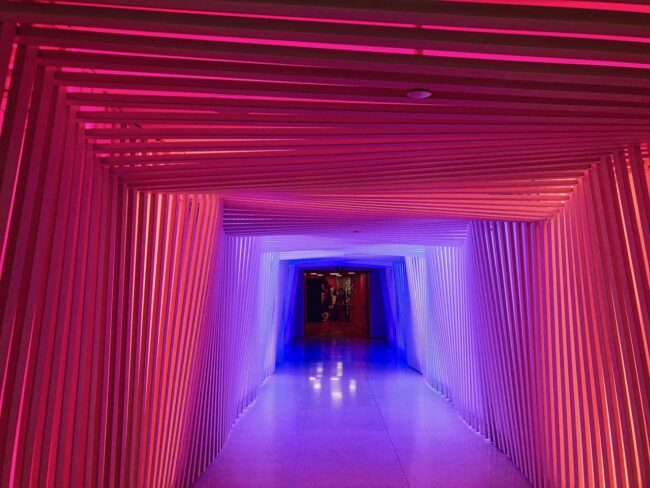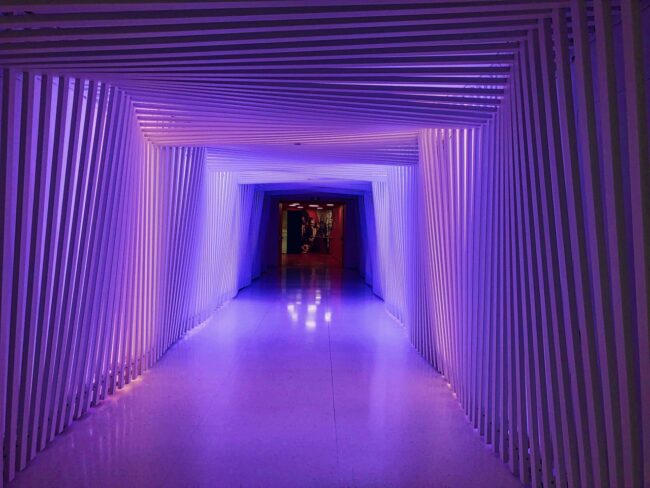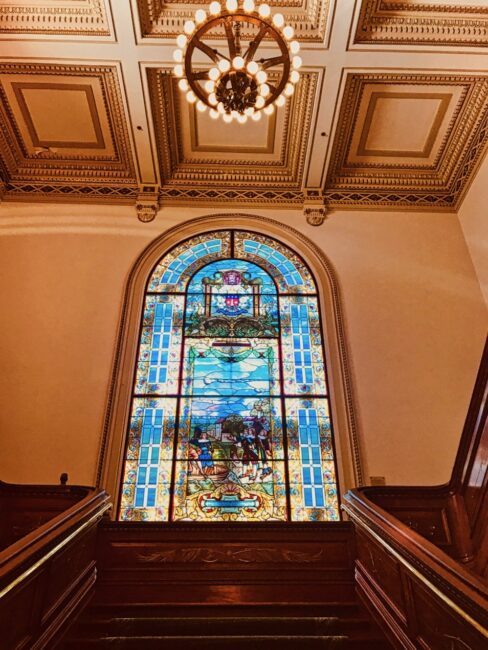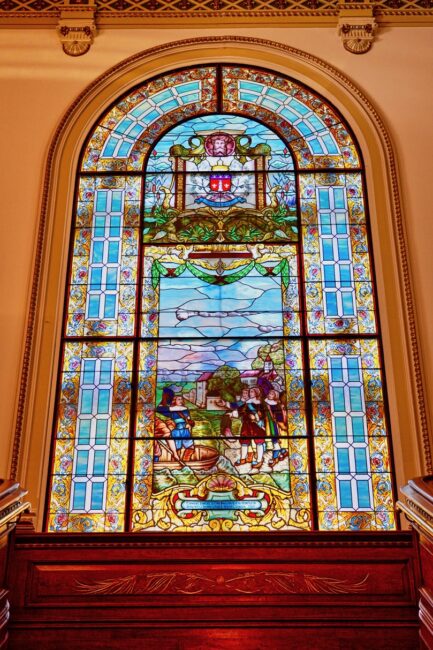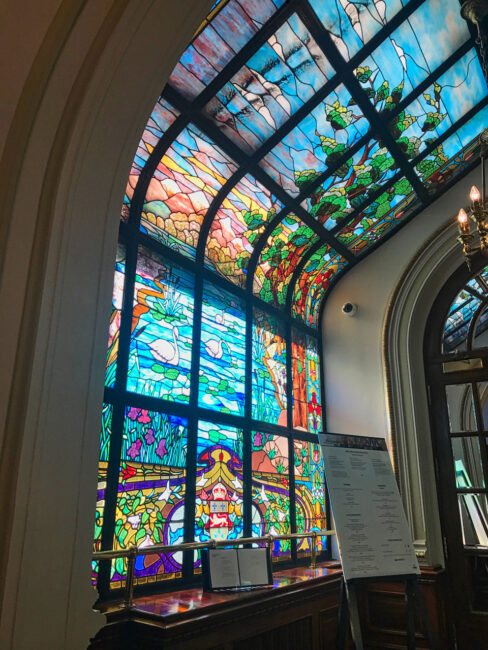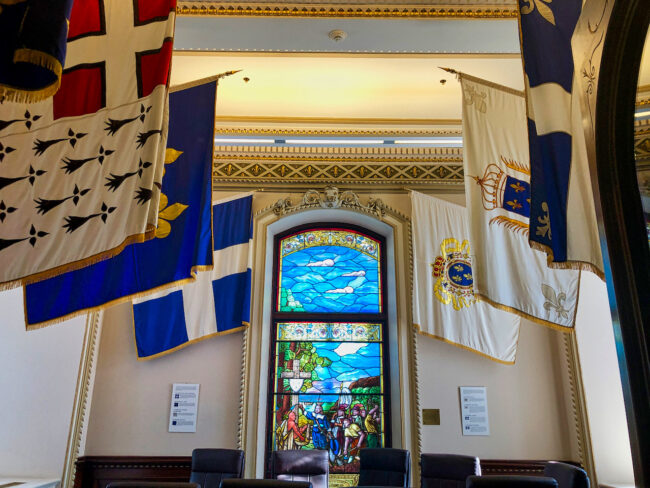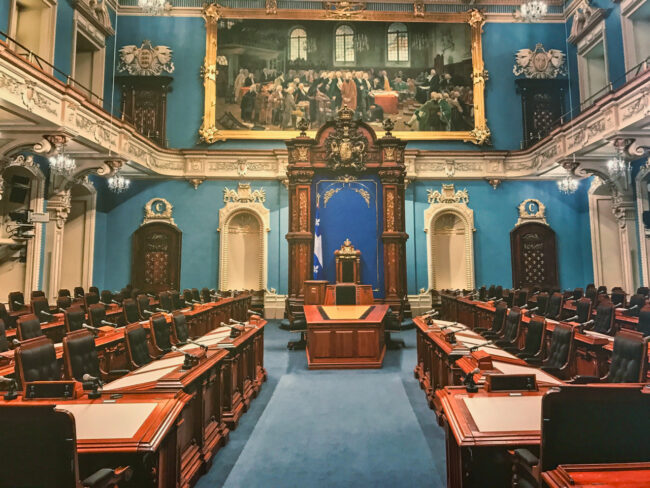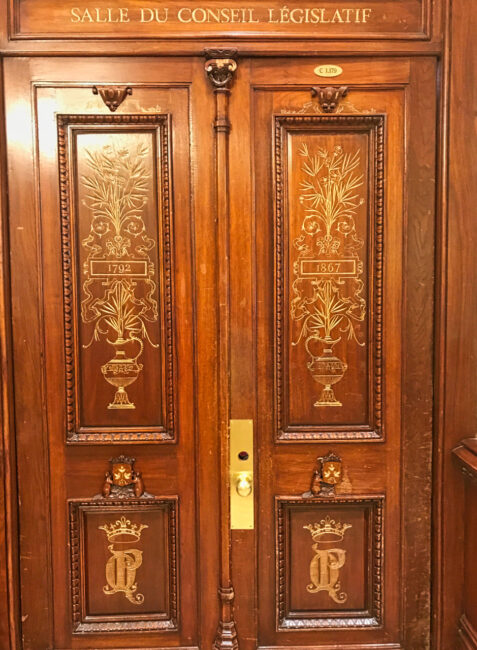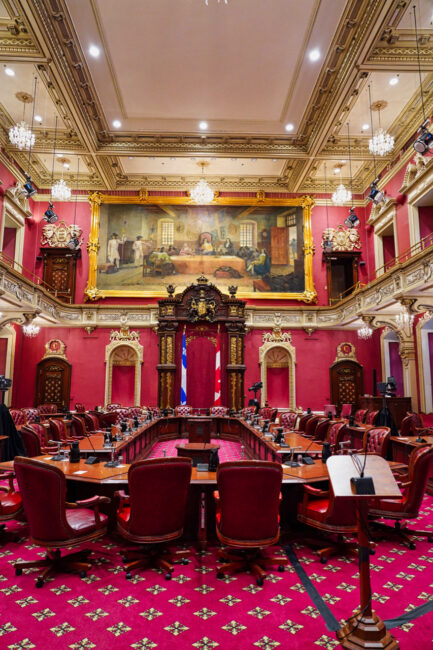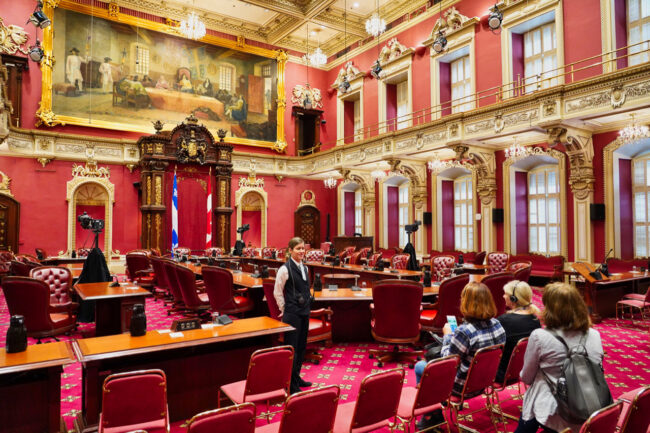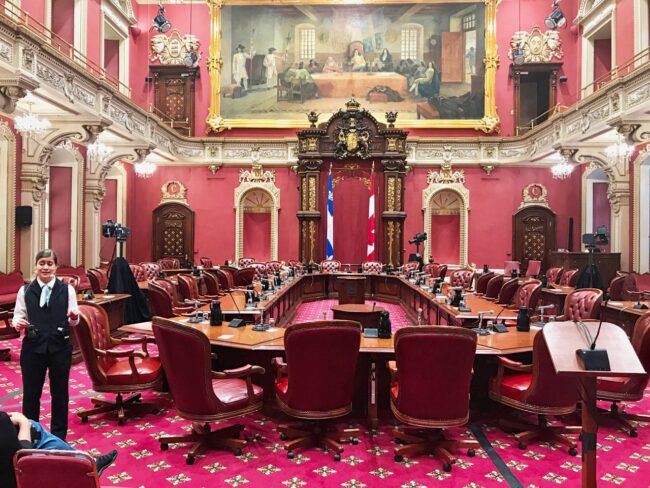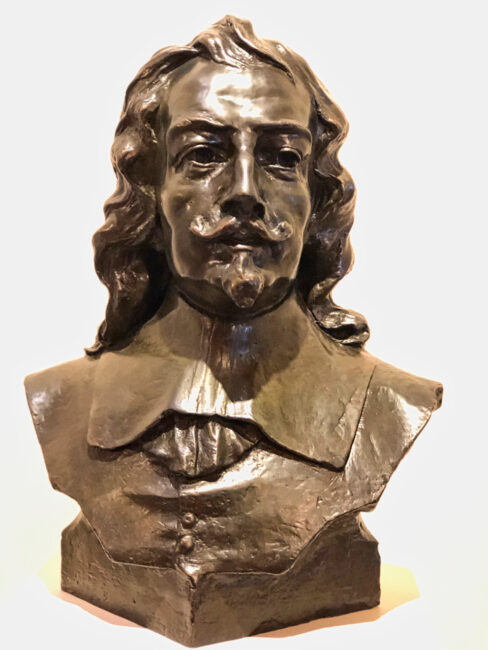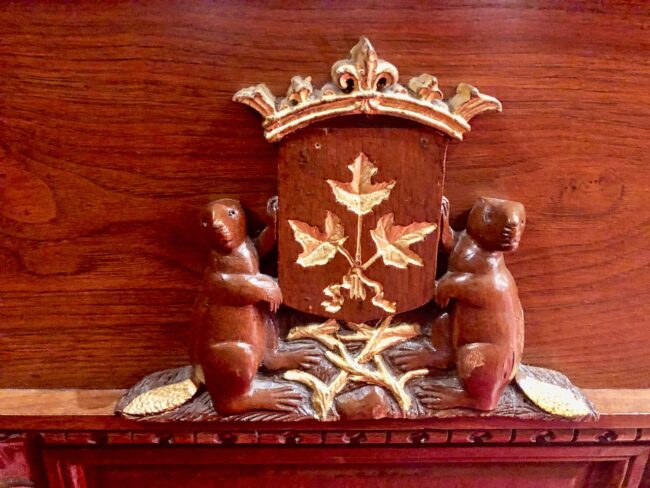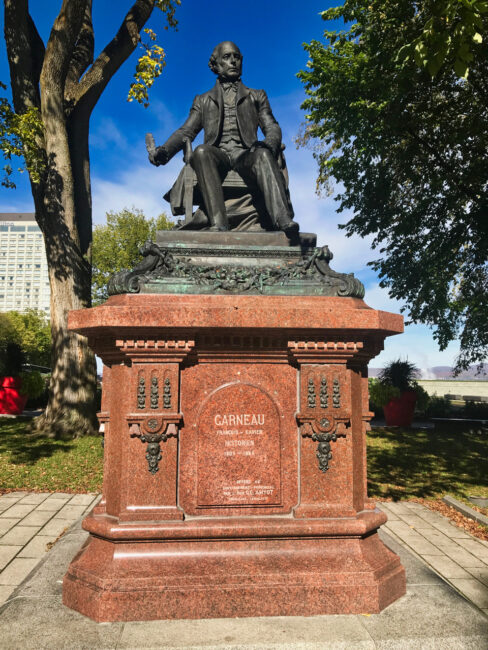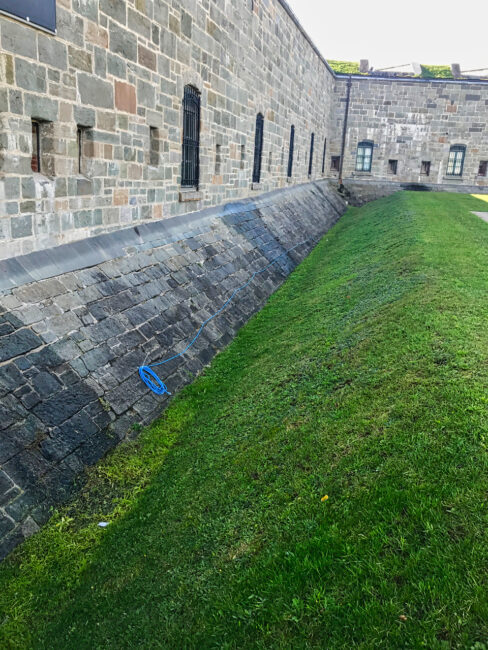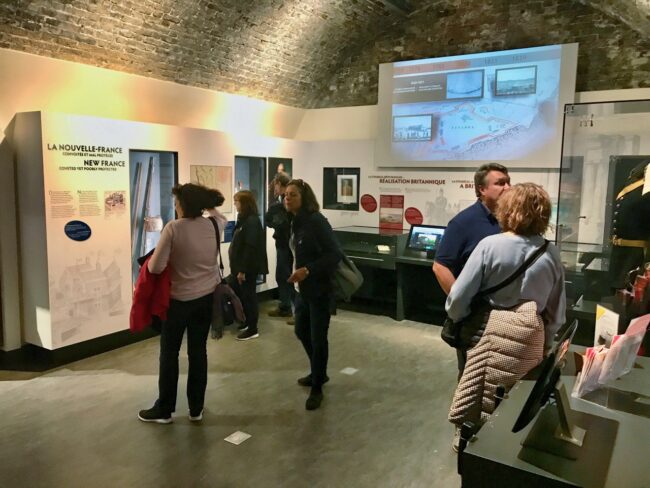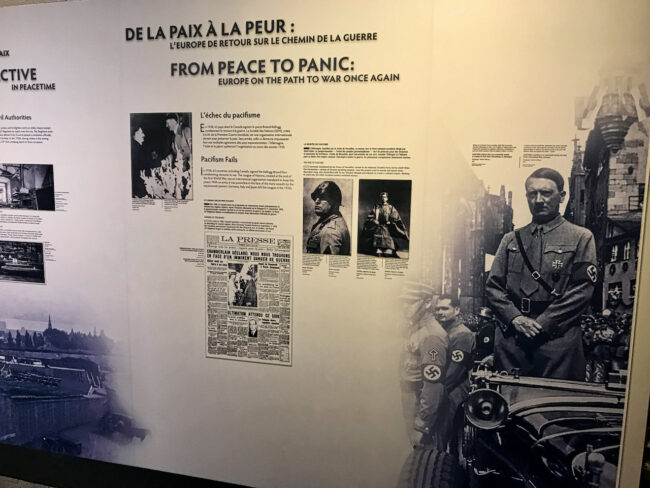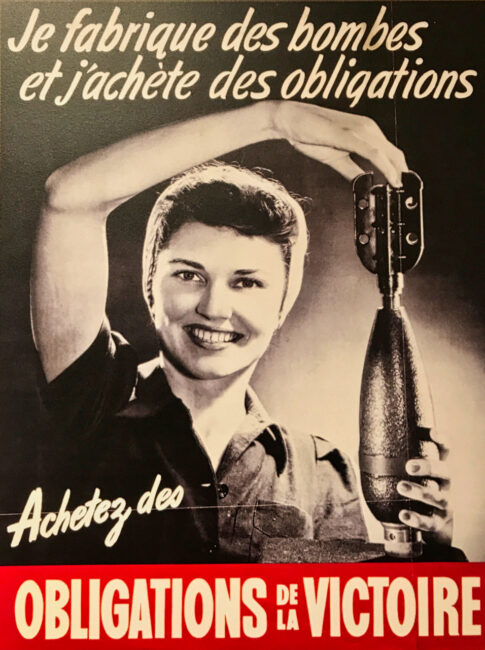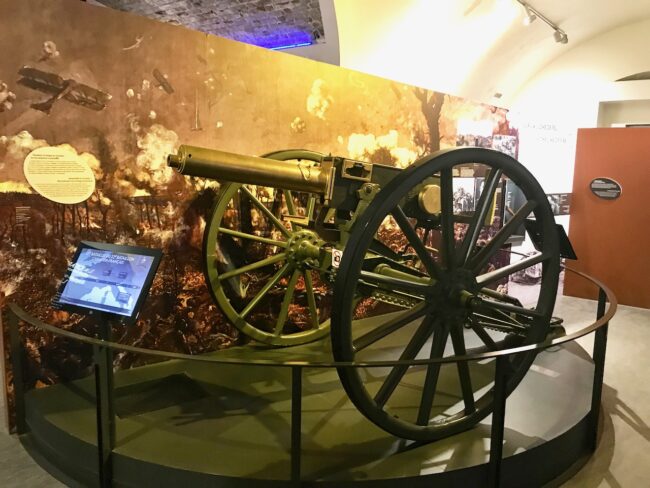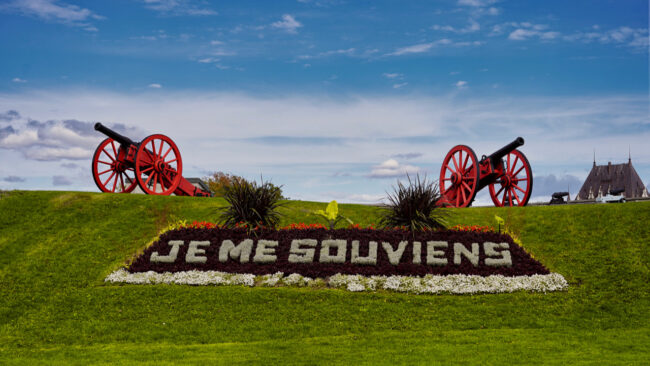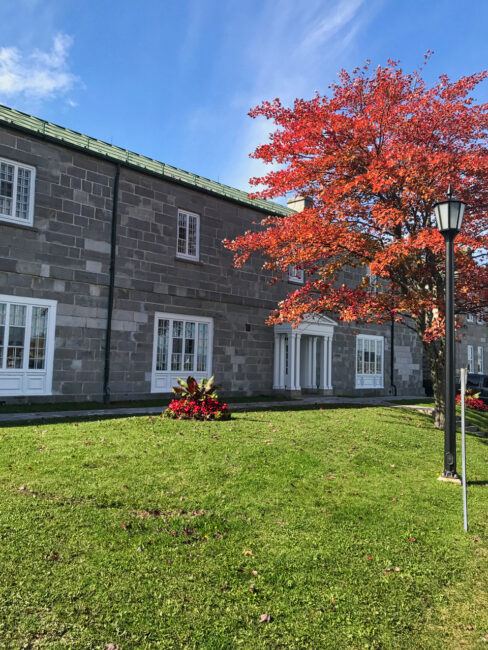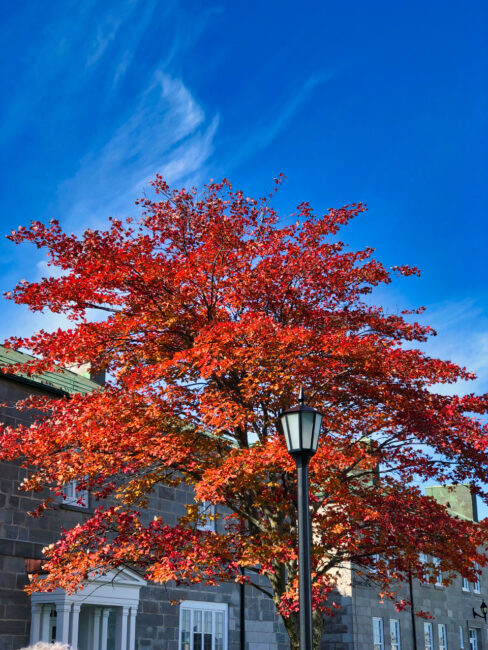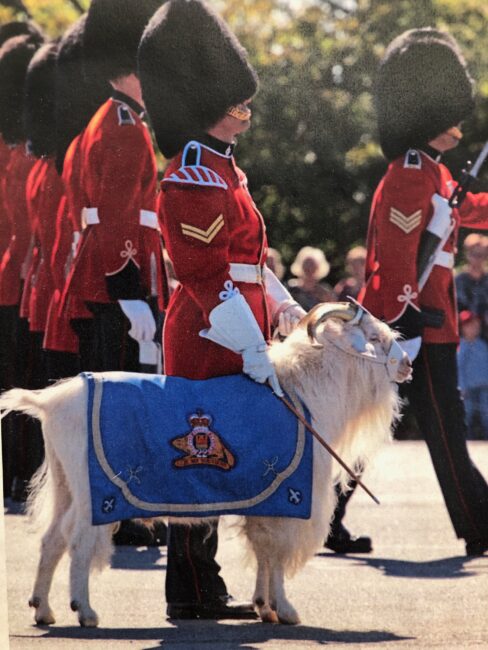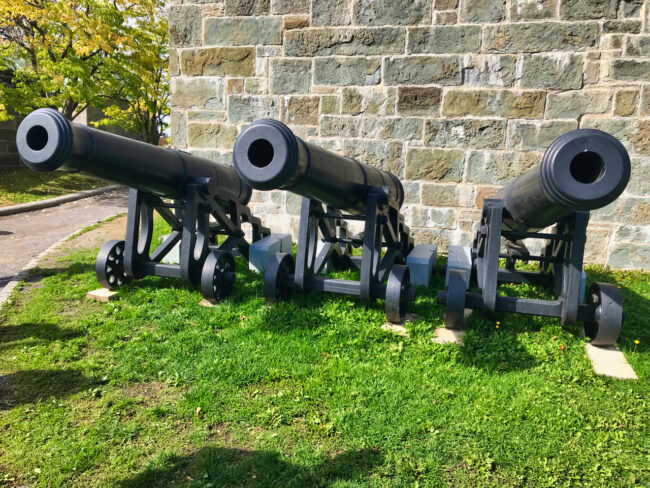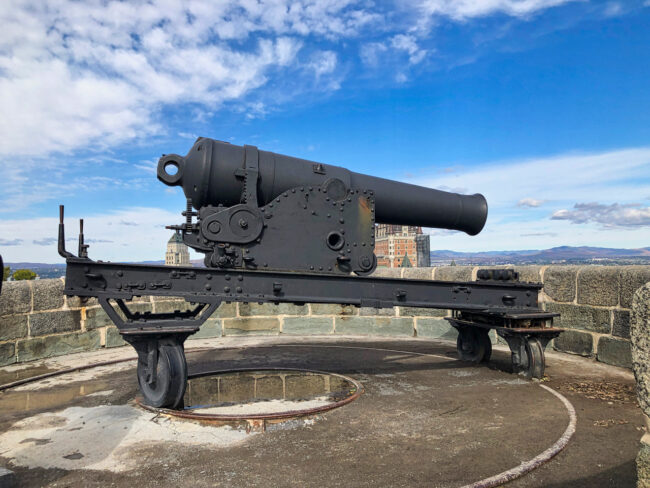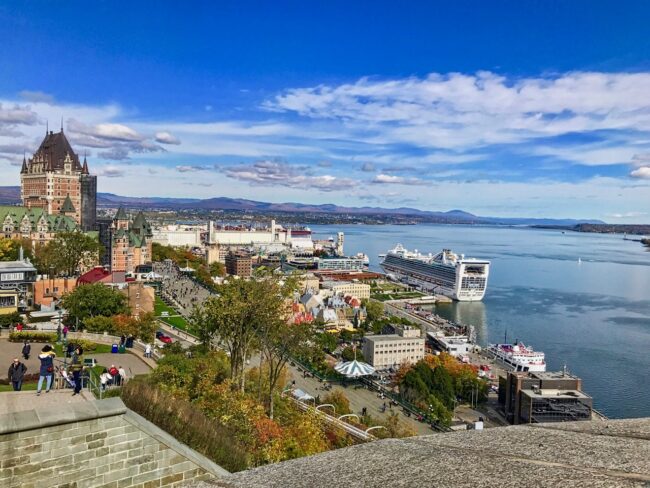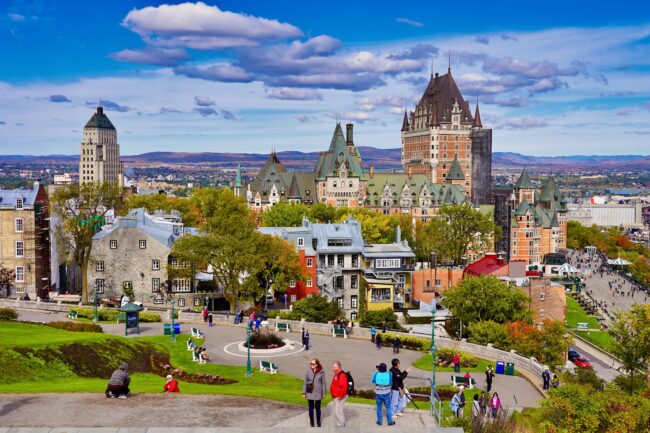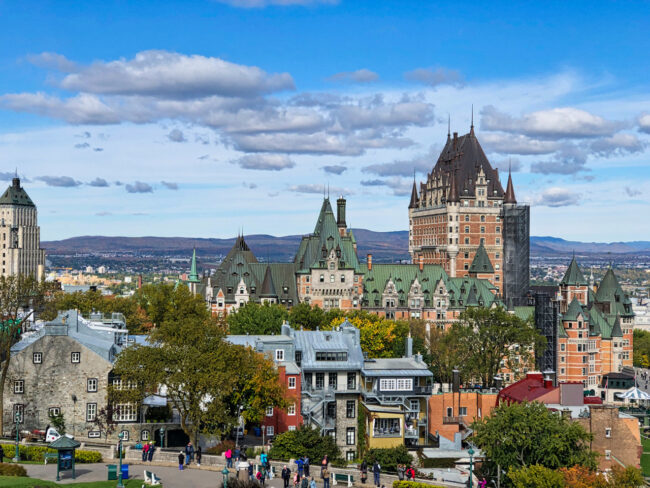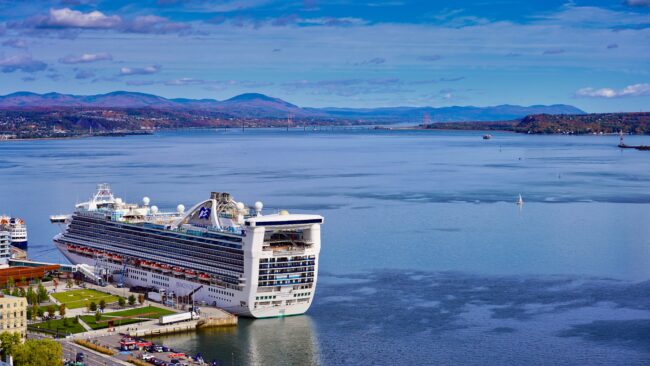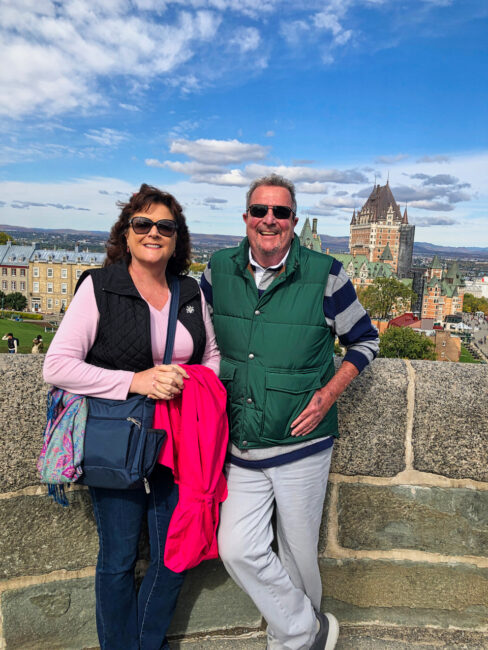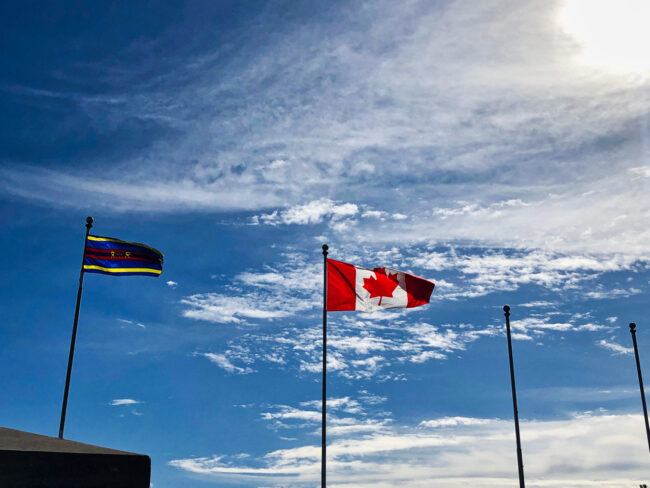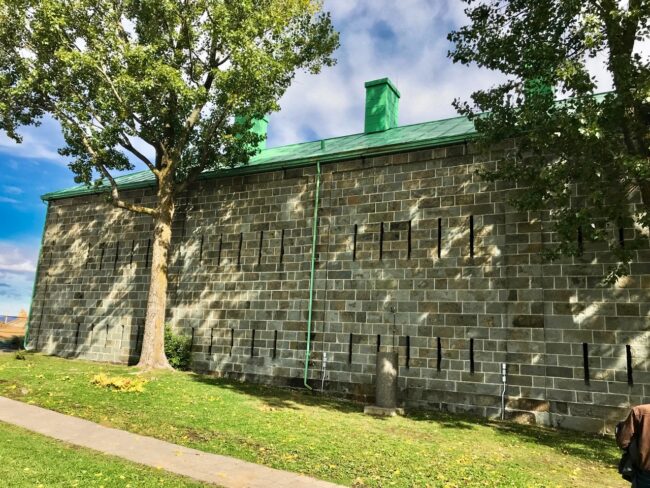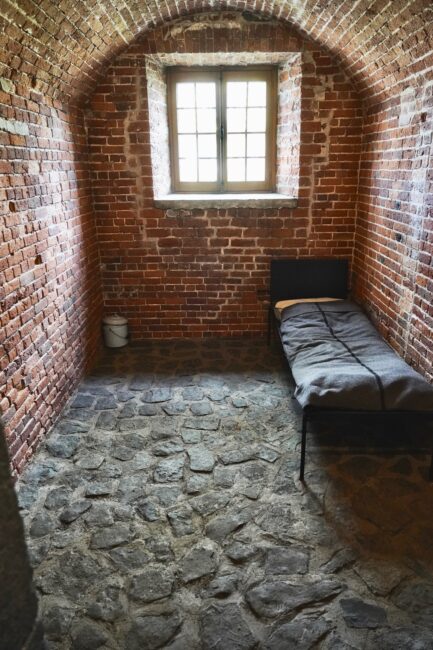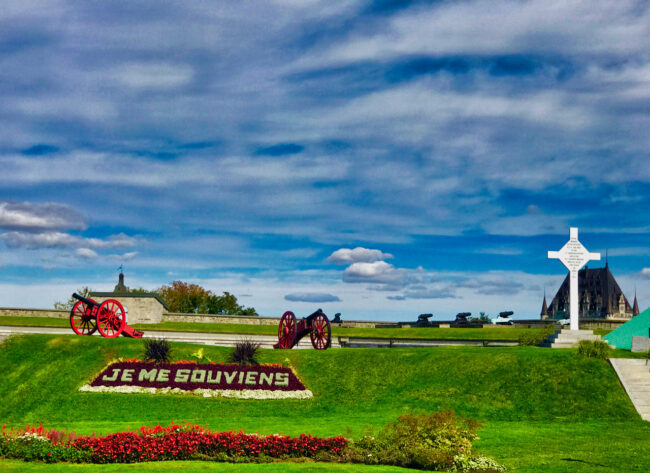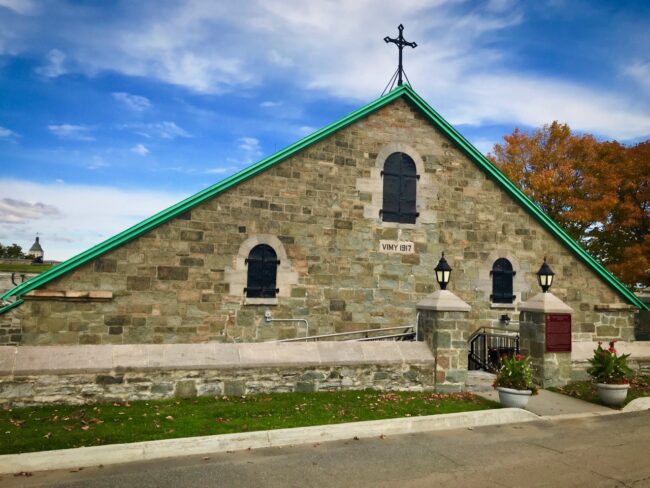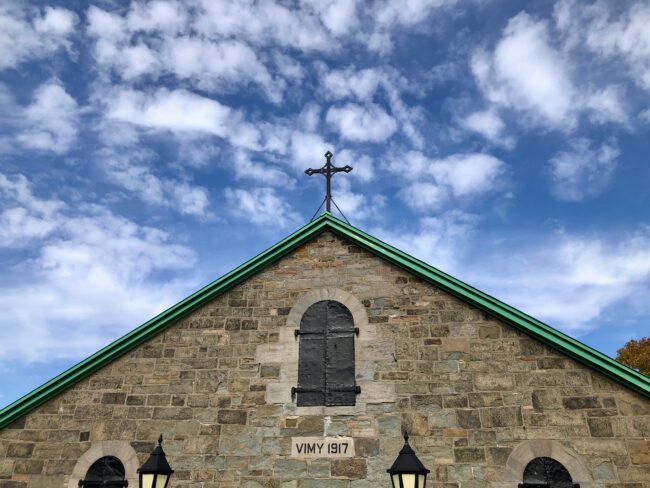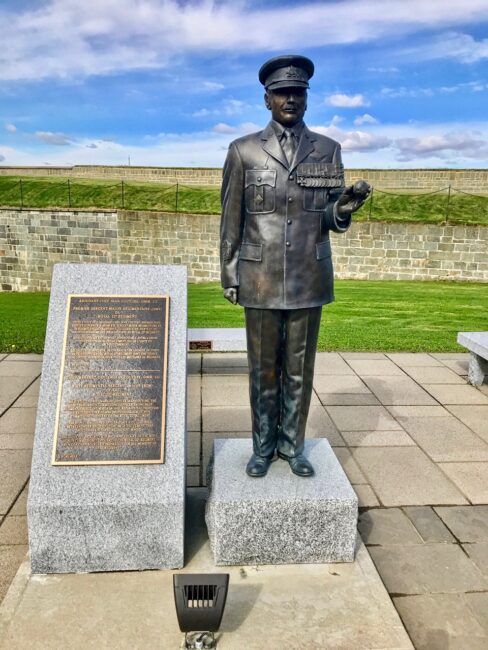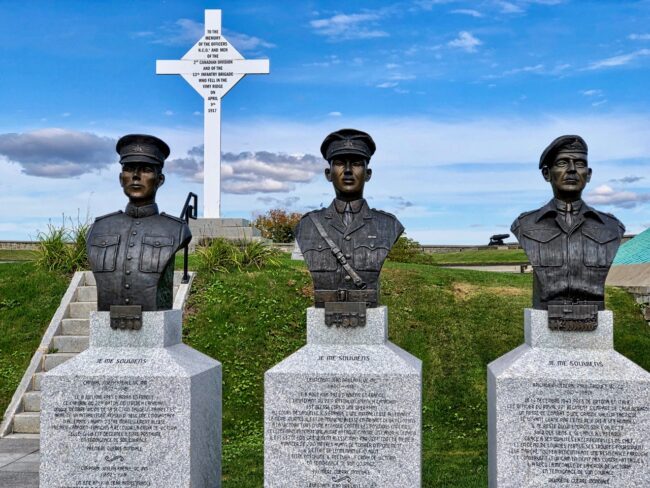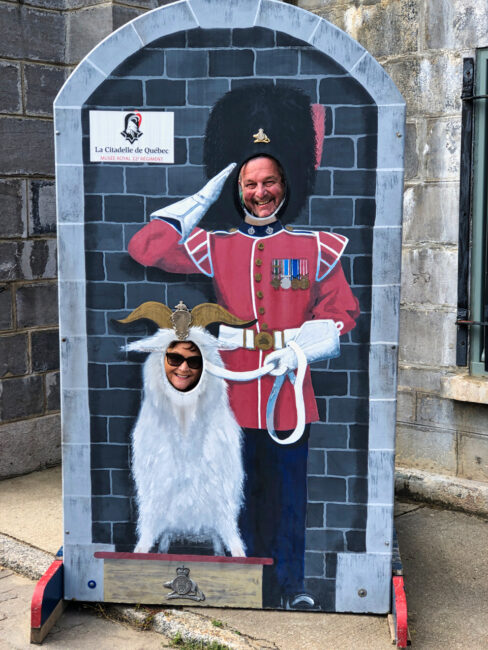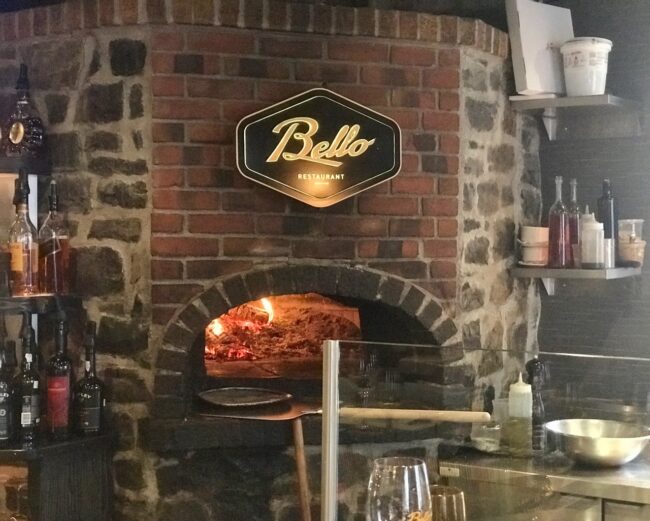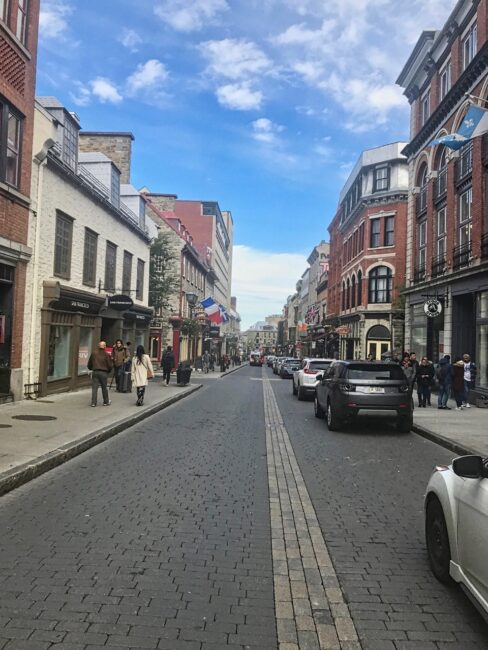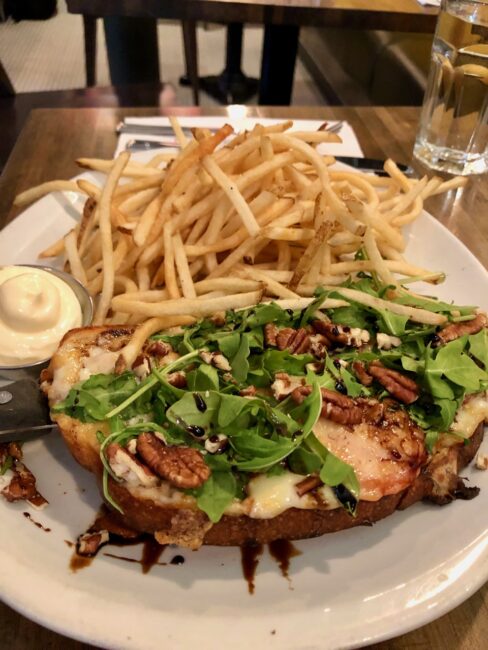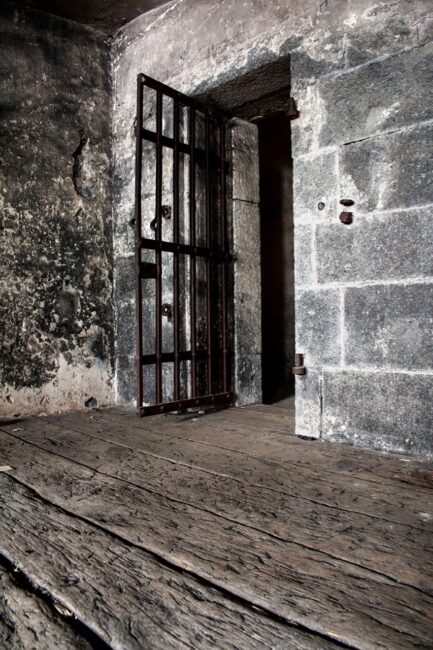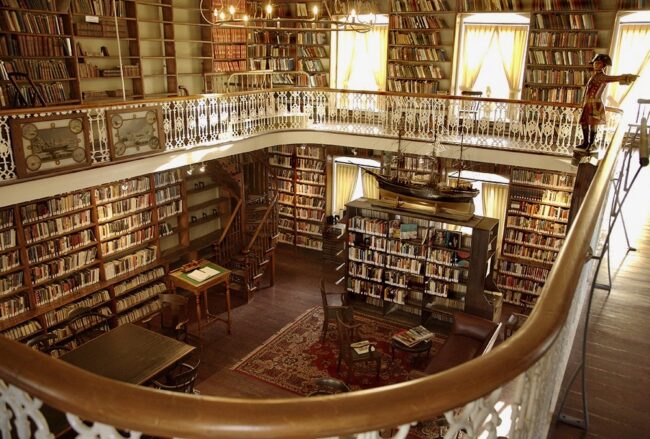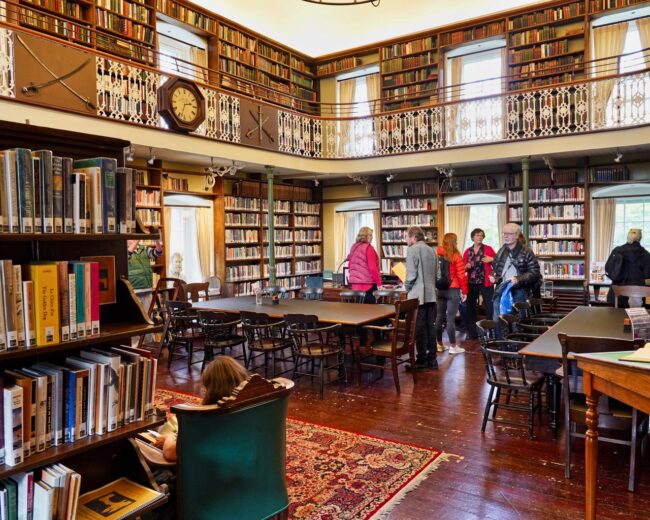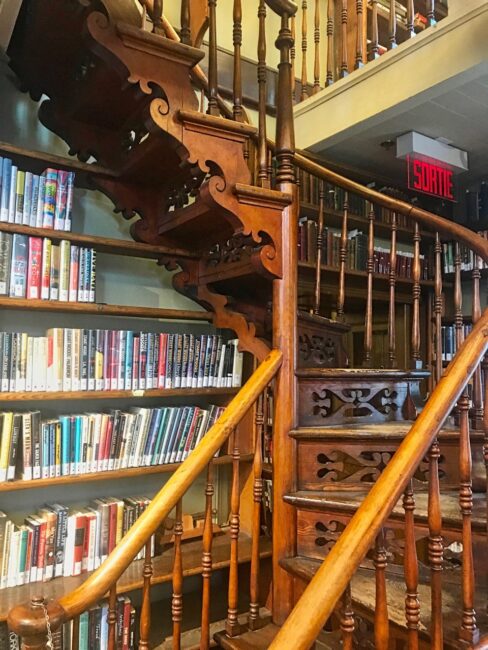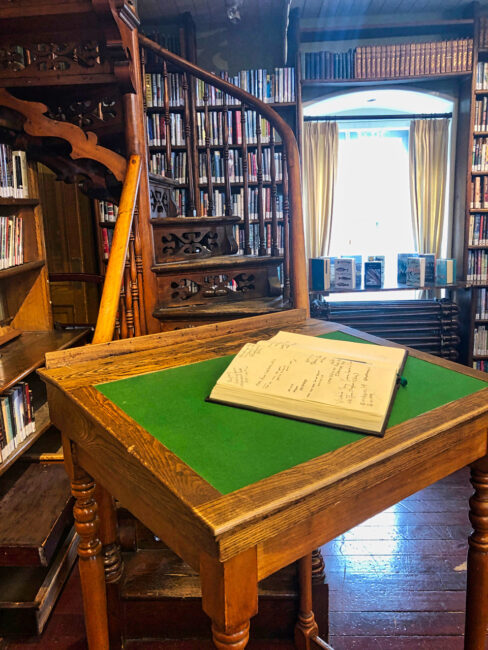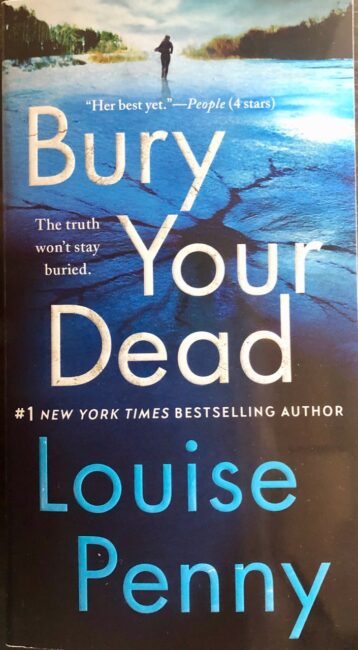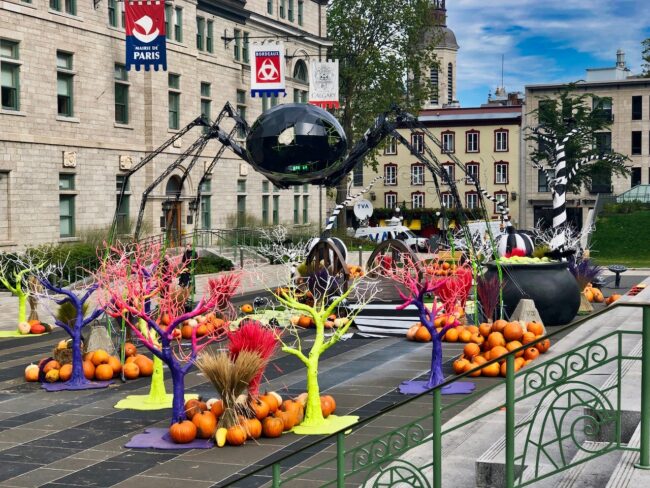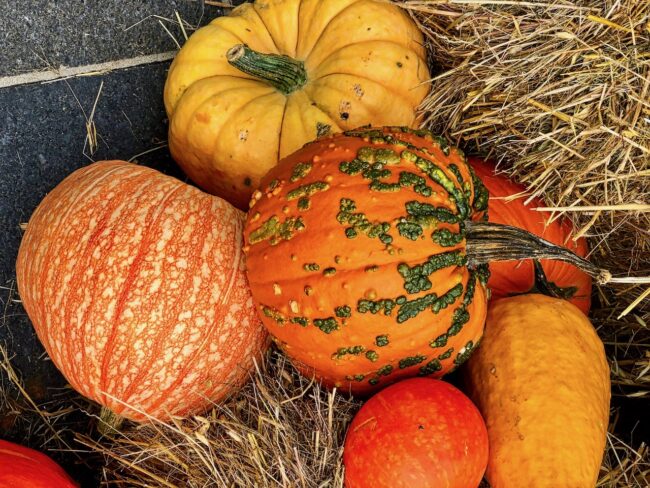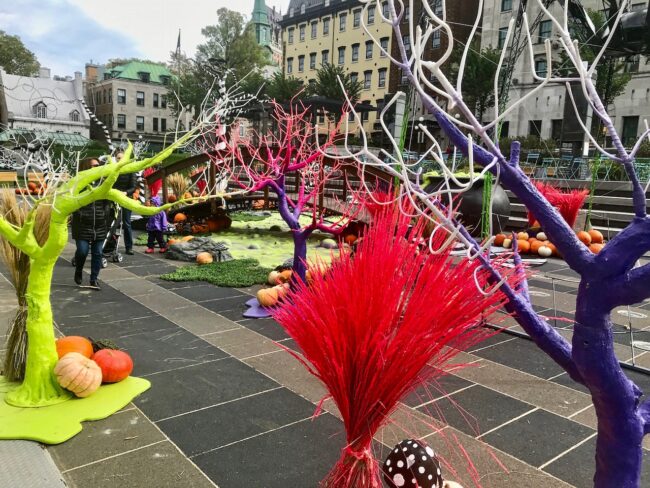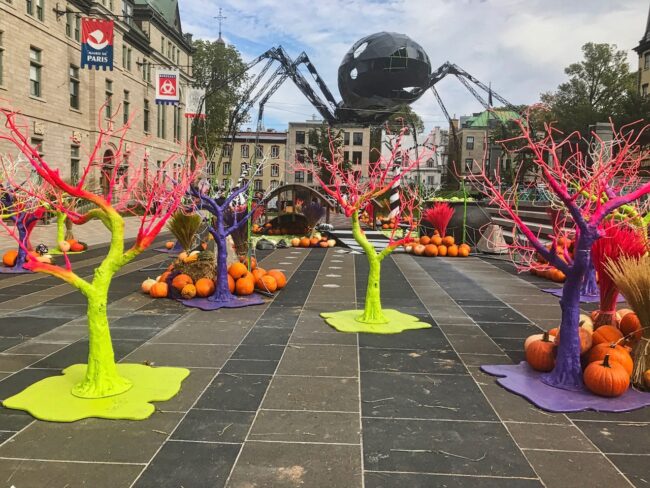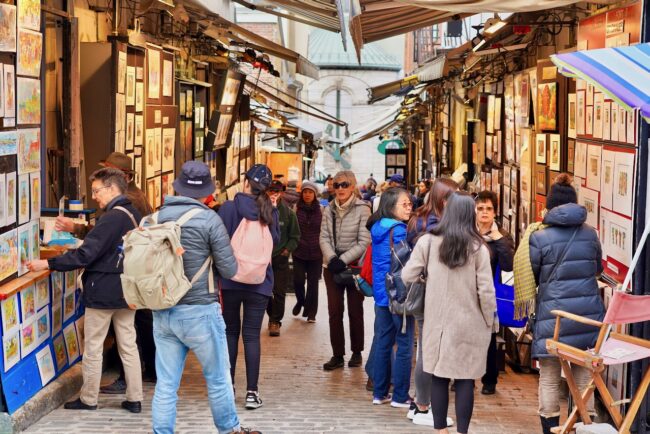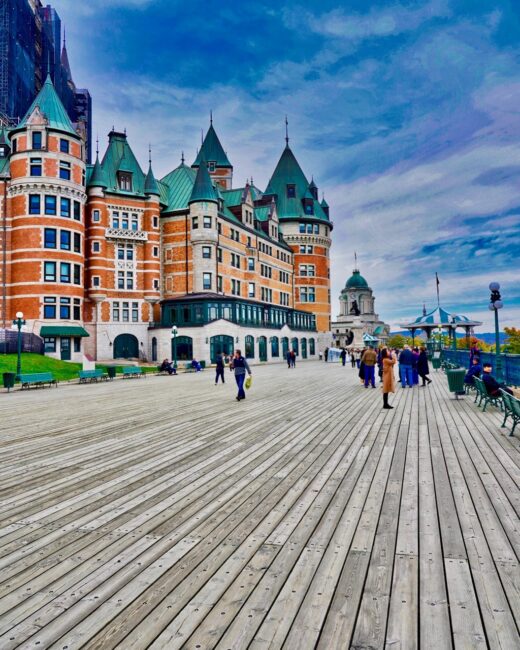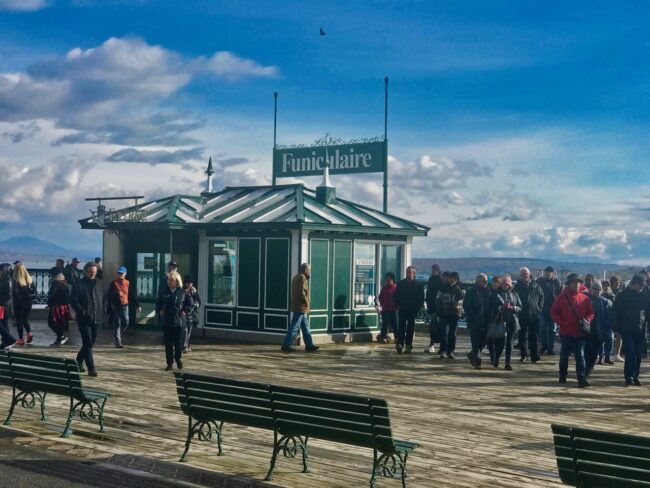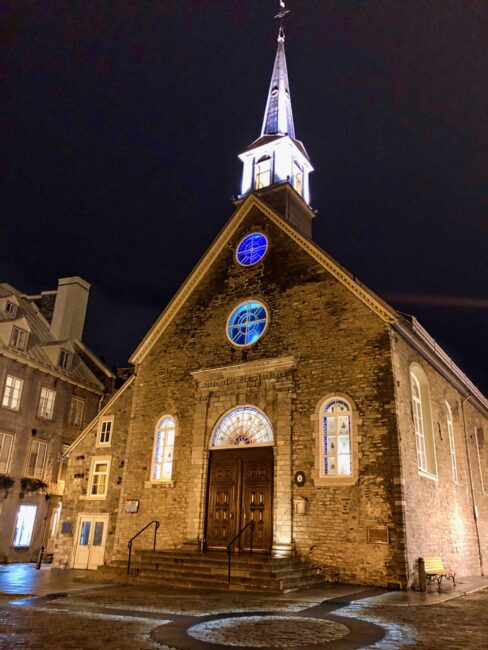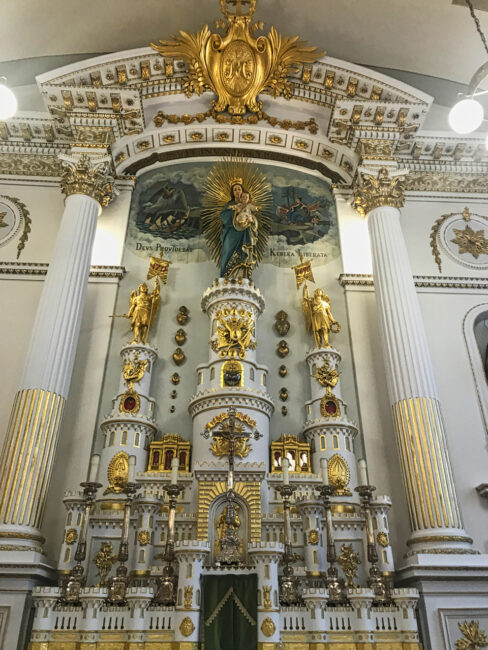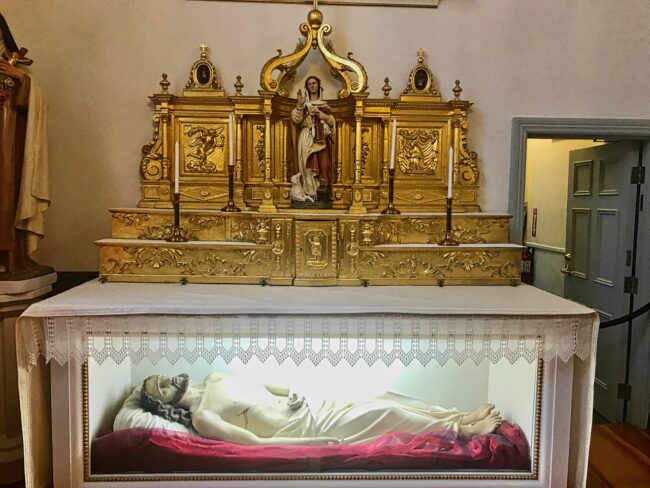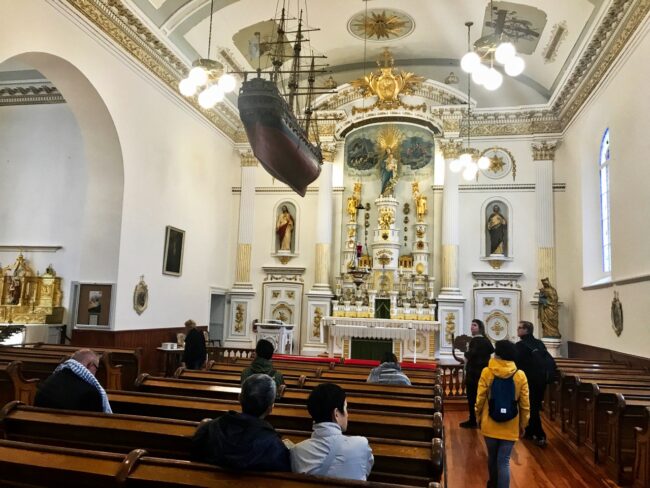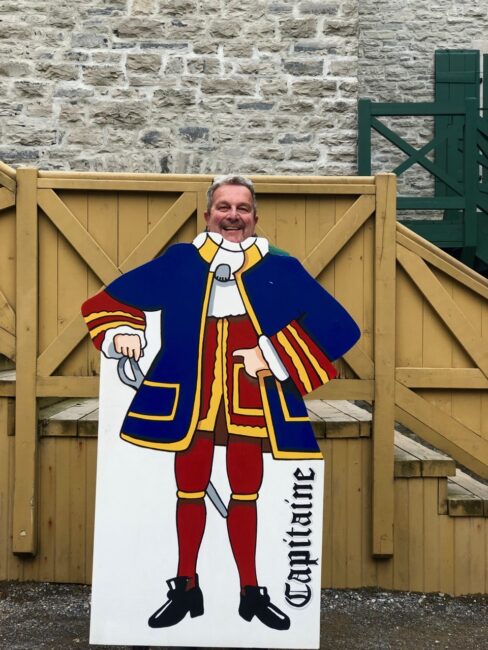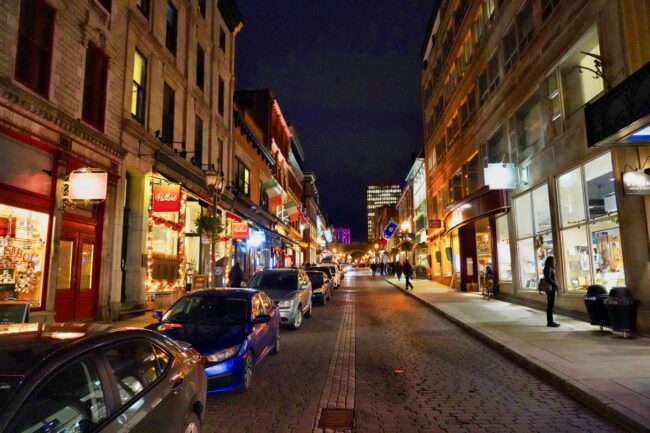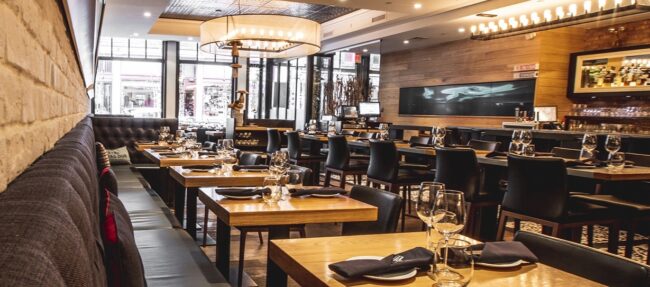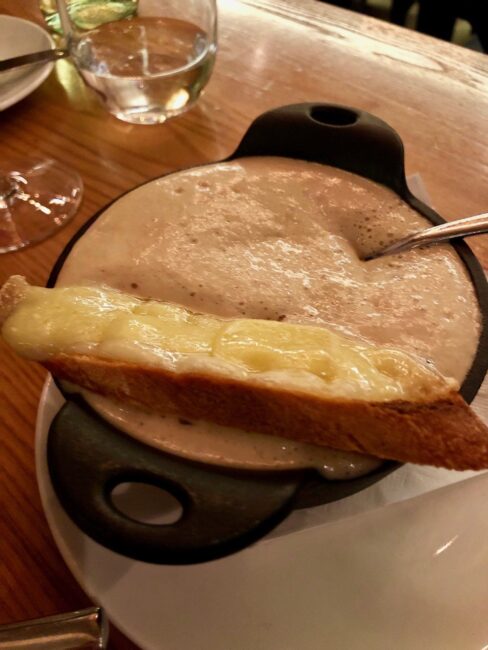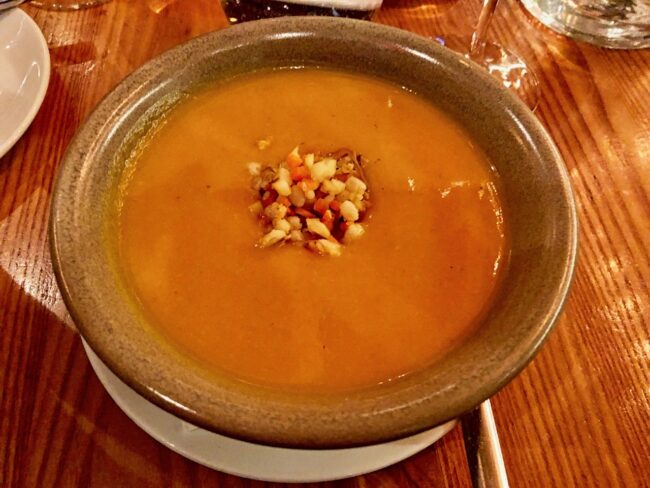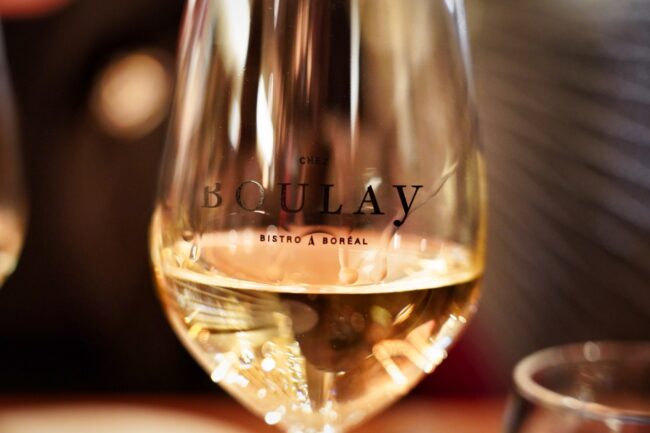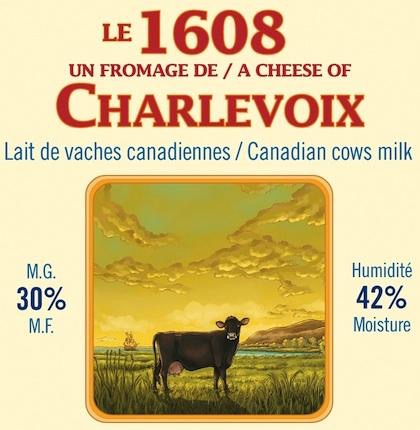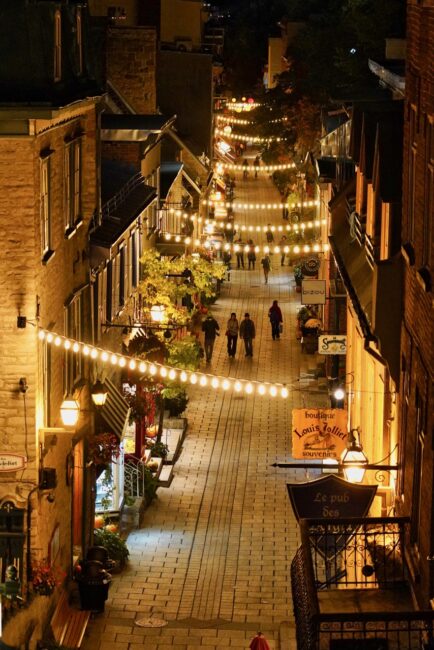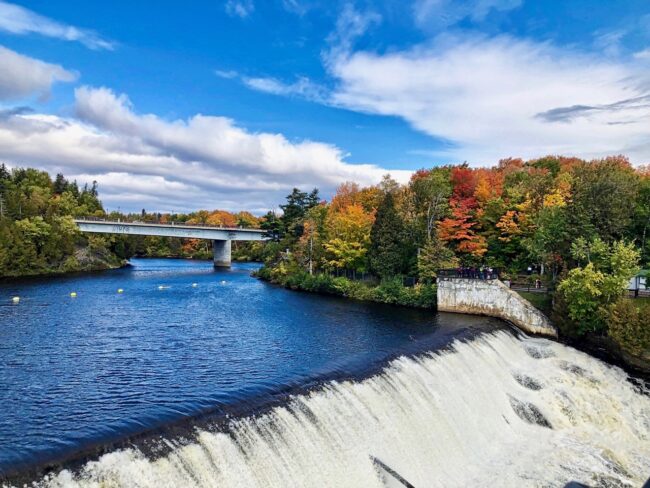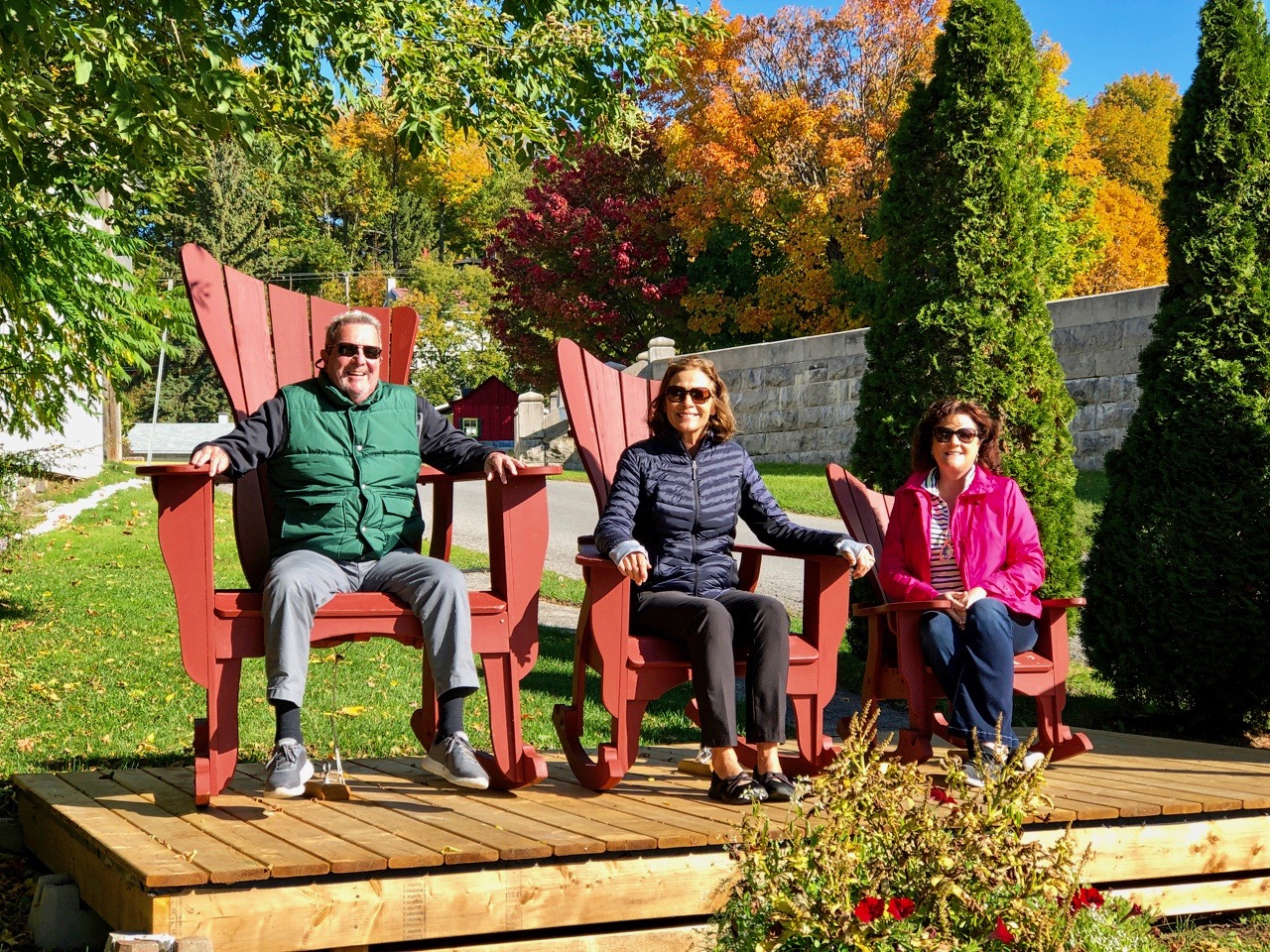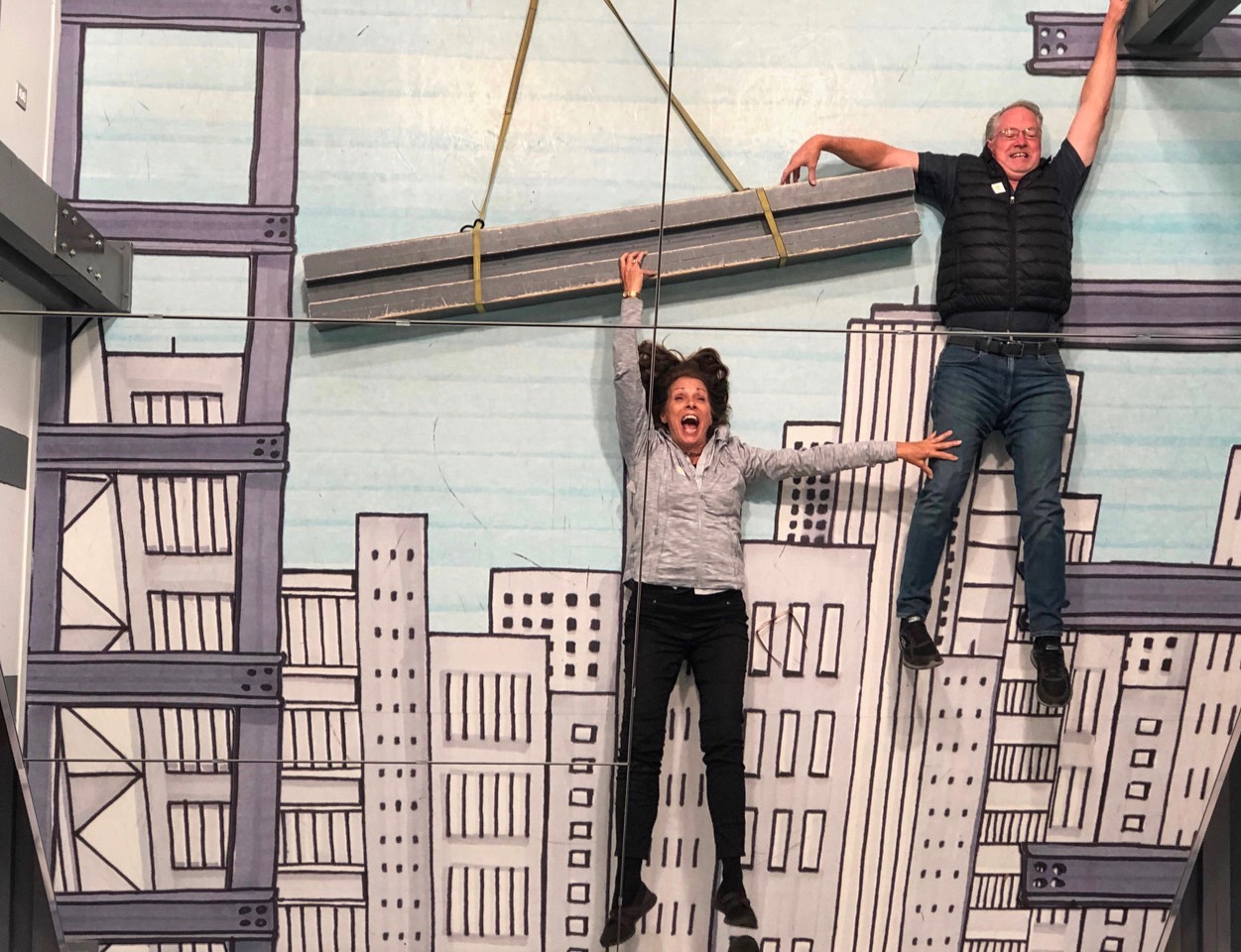
CHAPTER NINE: FALLING FOR QUÉBEC CITY
February 26, 2020
CHAPTER ELEVEN: DAY TRIPPIN’ – QUÉBEC’S AUTUMN COLORS SHINE BRIGHTLY
April 1, 2020Colorful Québec: Mai Tai Tom’s 2019 Journey To Montréal & Québec City
CHAPTER TEN: A QUÉBEC CITY CIVICS & HISTORY LESSON
Day Eight – A Visit From The Sun, Parliamentary Procedure, The Rainbow Tunnel, Behind Closed Doors, “I’m Making Bombs”, Hilarious (And Informative) Tour Guide, Rachel Takes A Shot, Don’t Paint The Goat Blue, Marvelous Views, Prison Time, The Chardonnay Shut Out, Prison Time (Part Deux), A Penny For Your Thoughts, BuryYour Dead, Art Alley, Pub Stop, Maple Whiskey and Changes In Latitudes, Changes In Attitudes
Stepping outside the Hotel Priori after another hearty breakfast, we were momentarily blinded by an unknown object hovering above us as it momentarily escaped from behind the clouds. Quickly shielding her eyes, Tracy exclaimed, “What is it?” In fact, it was something we hadn’t seen for days … the sun.
We quickly climbed inside the Ubermobile and were whisked to our first stop on this morning, Hôtel du Parlement, which is not a hotel at all. Québec City’s Parliament Building, located appropriately at the top of Parliament Hill, was constructed from the mid-1870s to the mid-1880s. Before we had left for Canada Kim had booked a 9:30 a.m. tour (free, but must be booked online) of this historic landmark.
Since we needed to arrive at our destination early (to go through security), we had plenty of time to scout out the exterior of the building. The seat of Québec’s provincial government is patterned after buildings in France and the U.S. in the late 19th century (it’s called Second Empire Architecture).
You can’t miss the huge fountain in front of the Hôtel du Parlement. Fontaine de Tourny actually originated in France. The fountain received a gold medal at the 1855 Paris World’s fair and then was located on an avenue in Bordeaux (one of Québec’s twin cities) from 1857 – 1960, when it was removed because of maintenance costs. It was eventually bought by a Paris antiques dealer in the early 21st century, and the owner of the Simons department stores purchased it at a flea market in 2003. Peter Simons helped to have it moved to Québec where it was renovated, and is now a city landmark.
Looking back toward the building, there are plenty of sculptures and statues. In front of the building stands the Honoré-Mercier Monument, dedicated to the ninth Premier of Quebec from 1887 to 1891.
The building itself also contains numerous statues, most relating to significant moments and people in Québec’s history.
Below is an Abenaki (a member of an Algonquian people living chiefly in Maine and Québec) fisherman with poised spear.
Once inside, after passing through security, we walked down a white spiral ramp into the bowels of the Parliament building. The area at the bottom is called the Oculus. On the walk down we witnessed some sort of etchings on the walls that we would learn about later.
At the Oculus, we met up with the rest of the 9:30 tour, where we were given headphones for a tour that lasts anywhere from an hour to 75 minutes.
A skylight with a very cool view caught our eyes as we gazed upward. The skylight “features a mirrored stainless steel drum that frames the central tower of the National Assembly.”
iPhones and cameras were put to immediate use.
As the tour began we walked back up the circular ramp. Those “etchings” we had seen earlier are wood panels “pierced with pixel-like dots” depicting scenes from Québec’s history. I believe this one depicts Canadian suffragettes, but since there was no David Bowie music playing, I can’t confirm that.
At one point we found ourselves in an area awash with colors.
It so happens that we were inside a permanent art installation by Jonathan Villeneuve called “Spectre de Lumière.” It reminded me of the laser light shows we used to go to in college (minus the extra stimulants we snuck in to add to the experience along with some Emerson, Lake & Palmer tunes).
Our next stop was the Escalier Principal (Grand Staircase) where colors of a different type took center stage. A gorgeous stained glass window depicting Champlain’s departure from France for Canada in 1608 stands prominently at the top of the stairs. After looking at this piece of art, nobody would dare sing, “I Get No Kick From Champlain.”
Other stained glass windows stood out, as well.
The central staircase took us to the floor of the Salle de l’Assemblée Nationale (National Assembly) and the Salle du Conseil Législatif (Legislative Council). The National Assembly was in session, so we were not allowed in, so the only picture of the “Le Salon bleu” was the one displayed in the hallway.
We were able to visit the Legislative Council (“Le Salon rouge”). I wondered if Charlie Rich was singing behind these closed doors.
Instead, our very informative tour guide Catherine explained what goes on here. Surrounded “by a tribune on three sides, there is the painting The Sovereign Council of the Royal Government of New France.”
Before the tour ended we checked out a bust of the ever-present Champlain, and you know I can never pass up anything where squirrels are represented. Editors note: I’ve been informed those are actually beavers, the symbol of Canada. This is why I was never the host of Wild Kingdom.
It was only about a ten minute walk to our next attraction, La Citadelle de Québec. First, we stopped by the statue of François-Xavier Garneau, the 19th-century French Canadian notary, poet, civil servant and liberal who wrote a three-volume history of the French Canadian nation.
La Citadelle de Québec … 1 Côte de la Citadelle (at rue St-Louis … was the brainchild of the Duke of Wellington, who believed the Americans would attack Québec City after the War of 1812. In actuality, there have never been shots fired in battle here (maybe we didn’t have a beef with Wellington). You really can’t see much of the area, until you are actually standing upon it (the second highest spot in Québec City). Admission ($CAD16 … Seniors $14) includes a guided tour of the Citadelle and its 25 buildings.
We first took a self-guided tour of the Musée Royal 22e Régiment.
It explores “the architectural heritage of the fortress and the regiment’s history through interviews, video archives, and interactive battle maps.” This looked like a “Rosie The Riveter” poster … Canadian-style.
We met with our guide, the funny and informative Sarah, who would lead us on the outside portion of the tour. La Citadelle de Québec was nicknamed the “Gibraltor of America.” “Je me souviens” is the official motto of Québec. Translated literally into English, it means “I remember.”
We walked by barracks and buildings of the Musée Royal 22e Régiment. La Citadelle de Québec is also “the secondary official residence of both the Canadian monarch and the Governor General of Canada.”
Looking at this sign, I surmised it was illegal for dogs to eat cats on the grounds.
Although no shots in battle have ever been fired here, many have been imbibed here. The problem came to a head when some drunk cadets took their mascot, a goat, and painted it blue. From then on, to prevent that kind of behavior, the mascot has been kept off the grounds. I kid you not.
We climbed toward what Sarah said would be the best view of Québec City. First, it was time for some fire power.
When you get to the highest point of the citadel you will say “hello” to the largest cannon on the premises, Rachel, a 9-ton cannon. It’s supposedly named after a beautiful woman who was loved by many of the soldiers. Sarah did not divulge any more details.
The views were as advertised.
From Le Château Frontenac …
… to the surrounding waterways and countryside …
… the tour group stopped for about ten minutes taking photos on this beautiful day.
We next visited The Tenaille. I told Tracy that for some reason I felt like singing Love Will Keep Us Together at the Tenaille, which is actually a place where troops could retreat if under attack (a “fortress within a fortress”). It was also used as a prison.
Our last stop took us back to near where the tour began.
The Vimy Cross (commemorating the sacrifice of Canadian soldiers at the Battle of Vimy Ridge during World War I) sits atop the Memorial Chapel.
Statues and busts commemorating those that served were nearby.
Of course, no visit to most sites we travel ends with a little bit of Mai Tai Tom-Foolery.
We had promised Mary that we would buy her a chardonnay at Bello (where we had that great lunch).
Unlike the previous day when the place was empty, when we opened the door there was not a seat to be found, so we dejectedly looked for another lunch spot. We stopped at Sapristo Bistro Bar where we had a decent lunch, with some good Flatbread dishes and a terrific Croque Monsieur.
Mary was very interested in the cultural center that once housed Québec City’s first prison. According to Atlas Obscura, “Originally constructed in 1712 as military barracks, the Morrin Centre was refit as Québec City Common Gaol (jail) in 1813. As the first and only penal city in young Québec City, public offenders were crammed in with one another with no consideration to their crimes, pairing drunkards with murderers, and prostitutes with scofflaws. The high balcony that looked out over the central area also pulled double duty as both a watchpoint and a gallows where people would be hanged from the iron railings.” (Two below photos are from the internet since tours of the old jail were unavailable on this day).
Today, the Morrin Centre is the only English-language library in Québec City. As Atlas Obscura added, “Given some of Quebec’s almost militaristic dislike of English speaking citizens, it’s probably best that the center is held in a fortress.”
Mary, however, had another reason for wanting to visit. “A penny for your thoughts?” I asked. “Funny you should say that,” she replied. It seems that in 2010, Louise Penny (an author Mary has become a fan of in recent years) published the crime novel, Bury Your Dead, and much of the book takes place at the Morrin Centre. It has become quite the tourist attraction for fans (who are dubbed “Penny People”) of the book and author.
Afterward, we strolled around, basking in the sunlight (although it was really cold), and passed by a playground that once again reminded us of autumn …
… and Halloween.
Mary and Kim never met an art exhibition they didn’t try to explore, so we walked down an alley where people were showing off their works.
Mary then asked, “What are we doing tomorrow?” It was supposed to be another glorious day, and since we had exhausted much of what we wanted to see, we headed over to the tourist office. Mary spied a tour that would take us to a couple of places I thought we might see on our way back to Montréal on Saturday, but this five-hour tour seemed like a perfect and relaxing manner to end our stay in Québec City, so we booked it.
Soon we were back at Le Château Frontenac.
Once again we hopped on the Funiculaire du Vieux-Quebec, which has been in operation since 1870. It had to be rebuilt in 1945 due to a fire. We took the 45-degree angled car safely downward.
It was nearing Happy Hour, which on our vacations is anytime after 8 a.m., and we found a great, little place. Pub de L’Oncle Antoin (29, rue St-Pierre) is located in the basement of an old house with really cool vaulted ceilings. The atmosphere, people and music were amazing, and the drinks were satisfying, too. It was dark inside, but one TripAdvisor pro used some photo tricks to get this great shot.
Once again, speaking of shots, a patron talked us into a shot of Maple Whiskey (a pretty easy sell). It was quite good.
We walked back through Place Royale, “considered by Québécois to be the literal and spiritual heart of Basse-Ville … in grander terms, the birthplace of French America.”
I had attempted on a few occasions to enter the church (Église Notre-Dame-des-Victoires) located on this square, but it had been closed. Today, it was unlocked. (here’s a night photo of church that Kim shot)
Église Notre-Dame-des-Victoires is one of the oldest churches in North America, built on the ruins of Samuel Champlain’s first outpost. It was rebuilt in 1763.
Inside the church is a model of the Brézé, a ship commanded by the Marquis of Tracy (coincidence?).
Back outside, once again my thoughts turned to Tony Tennille.
The group rested up because we were in store for a unique dining experience. We had 7:30 dinner reservations at a popular Québec City dining establishment. Speaking of reservations, a few of our group had them about the menu, too. Chez Boulay-bistro boréal (1110 Rue Saint-Jean) located in the heart of Old Québec City features “Nordic Cuisine,” a cuisine unknown to us.
When we first viewed the menu we were not sure we were going to like this restaurant as some of the items were outside our comfort zone (seared seal meatloaf). However, when in Rome or Québec City …. (photo from Chez Boulay website)
I started with an interesting (and stupendous) deconstructed French onion soup. Called a “cappuccino onion soup,” this hearty, delicious onion soup was topped with an emulsified foam ala cappuccino ($13). We thought it was a cheese foam, but the server told us that the only cheese in the soup was on the crostini served with the soup. Whatever it was, the soup elicited a Wow! from moi.
Tracy and Mary both ordered the soup special which on this evening was butternut and cauliflower. Tracy thought it was a tad bland, but Mary liked it (and so did I when I stole a spoonful … or two)
For the main course, Tracy and I both ordered the flat iron steak on a bed of roasted carrots, caramelized onions and fresh herbs with sour cream ($30) which was served with a side of pont-neuf fries. This was the most tender, delicious steak of the trip. Perfectly cooked, another Wow! dish.
Kim and Mary had the roasted guinea fowl breast, mashed and fried potatoes with garlic flower, roasted green beans with camelina, 1608 cheese croquette and poultry cooking jus ($27). Kim thought they were the most delicious green beans he had ever eaten and tried to figure out how to make them at home. Pretty sure this was a Wow! dish for them too.
Digression: We frequently saw 1608 cheese on menus in Quebec City which we subsequently learned from Cheesehound was: “Laiterie Charlevoix is owned by the Labbé family. The family wanted to create a superior cheese to commemorate the 400th anniversary of the settlement of Quebec City (which occurred in 1608, hence the cheese’s name). To help perfect the recipe and affinage, the family brought in a cheesemaking instructor from France. The cheese is made from the milk of the Vache Canadienne cow. The Vache Canadienne is a dairy breed developed in French Canada from cattle imported from Brittany and Normandy shortly after the settlement of Quebec. It is the only breed of dairy cow native to North America.”
Although we did not save room for dessert, our server said the best dessert on the menu was the Sea buckthorn and meringue pie, crème anglaise with caraway seeds ($10). We will have to get it next time.
It was a Black Velvet sky as we walked back to the hotel to try and shed the pounds we had just gained. The streets were nearly empty as the cruise ship people were back aboard, leaving old Québec City peaceful.
Tomorrow, we would be whisked by bus to an incredibly beautiful waterfall, an island where we would sample some delectable ice cream while gazing at some eye-popping autumn colors and a basilica that attracts more than one million pilgrims each year from around the globe.
Our Canadian adventure was drawing to a close.
NEXT: CHAPTER ELEVEN: QUÉBEC’S AUTUMN COLORS SHINE BRIGHTLY
DAY TEN – Bus Driver Extraordinaire, Cascading Chute, Colors Aplenty, Old Man Walking, Is That Wilford Brimley?, Cone Heads, Copper Clappers, Not JR Tolkien’s House, A Basilica To Remember, Fall At The Falls, Blaming The GPS and A Final Farewell To Québec City

